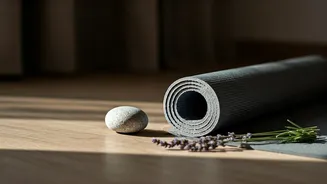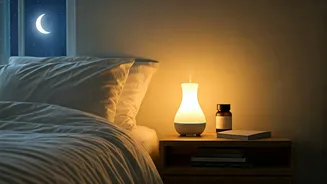Setting the Stage
To begin this journey towards relaxation, it's essential to establish a serene environment. Dim the lights, creating a tranquil ambiance that signals to your
body it's time to wind down. Minimize distractions by silencing your phone and other devices, allowing you to fully focus on the present moment. Find a quiet space where you can comfortably stretch out without interruption. Consider using a soft mat or a comfortable blanket to enhance your experience. This mindful preparation sets the tone for a deeply relaxing yoga practice, priming your mind and body for the exercises ahead, ultimately leading to a more restful sleep and a refreshed feeling the following morning. Preparing a designated space is like preparing the canvas before you start painting.
Gentle Breathing Exercises
The cornerstone of this relaxation routine lies in deliberate breathing exercises. Begin with deep, slow breaths, inhaling through your nose and exhaling through your mouth. This simple act of focusing on your breath helps to calm your nervous system, slowing down your heart rate and reducing stress levels. Practice diaphragmatic breathing, also known as belly breathing, by placing one hand on your chest and the other on your stomach. As you inhale, feel your stomach rise, and as you exhale, feel it fall. This technique promotes deep, efficient breathing, which is crucial for relaxation. Repeat this for several minutes, allowing the rhythm of your breath to guide you into a state of tranquility. A relaxed mind can always achieve better results.
Easy Yoga Poses
Following the breathing exercises, incorporate gentle yoga poses designed to release tension and promote relaxation. Child's pose is a classic posture, involving kneeling, bringing your forehead to the floor, and extending your arms forward. This pose gently stretches your back and hips, releasing stress stored in these areas. Another beneficial pose is supine spinal twist. Lying on your back, bend your knees and twist them to one side, keeping your shoulders flat on the floor, and repeating it on the other side. This twisting motion massages the spine and promotes relaxation. These gentle poses can be done for a few minutes each, allowing your body to unwind and prepare for a restful sleep. Consistency is the key.
Guided Meditation
Integrate a short guided meditation into your routine to further calm your mind. There are numerous guided meditations available online, and they can direct you through visualizations, body scans, and affirmations to promote relaxation. You can focus on a calming image or concept, like a serene landscape or a peaceful mantra, to quiet your mind. A body scan involves mentally moving through each part of your body, noticing any areas of tension and consciously relaxing them. Affirmations are positive statements that can help reshape your thoughts and emotions. Practicing meditation can have a profound impact on your mental state, reducing anxiety and stress, and improving your overall sense of well-being. Regular practice will boost mental capacity.
Cooling Down and Resting
After completing the poses and meditation, it’s essential to cool down and prepare for sleep. Lie in the Savasana pose, also known as corpse pose, which is the final resting posture. In this pose, you lie flat on your back, with your arms at your sides and your palms facing upwards. Close your eyes and allow your body to completely relax, letting go of any remaining tension. Focus on your breath and let go of any thoughts or worries. Stay in this pose for about 5-10 minutes, allowing your mind and body to fully absorb the benefits of the practice. Savasana is like the final curtain call; it's the period when all the hard work pays off, and it allows the body to restore.
Enhancing the Routine
To further enhance your relaxation routine, consider additional elements that promote a calming environment. Incorporate aromatherapy using essential oils like lavender or chamomile, which are known for their relaxing properties. You can diffuse these oils or add a few drops to your bath. Drink a cup of herbal tea, such as chamomile or valerian root tea, before bed. These teas can help soothe your nerves and promote sleep. Listening to calming music, nature sounds, or white noise can also help block out distractions and create a peaceful atmosphere. Consistency in incorporating these practices can help you create a personalized relaxation routine that effectively combats stress and helps you achieve a more restful and rejuvenating sleep. Personalization is the key.











